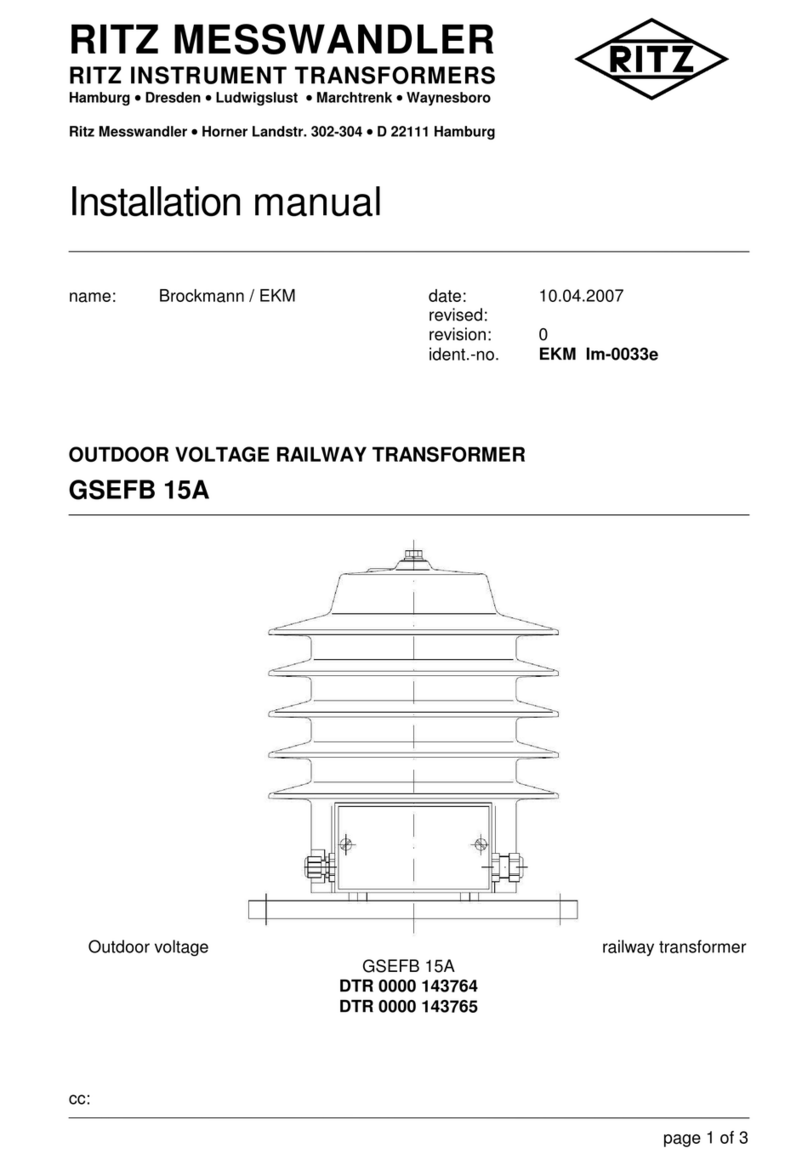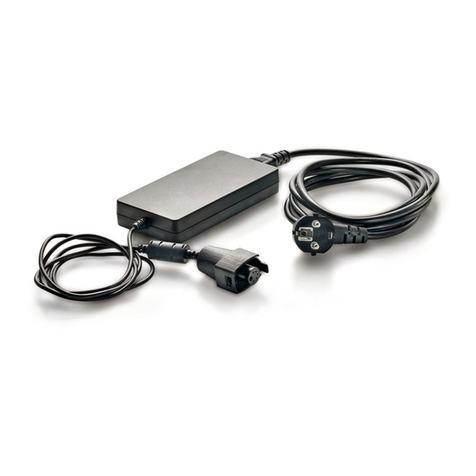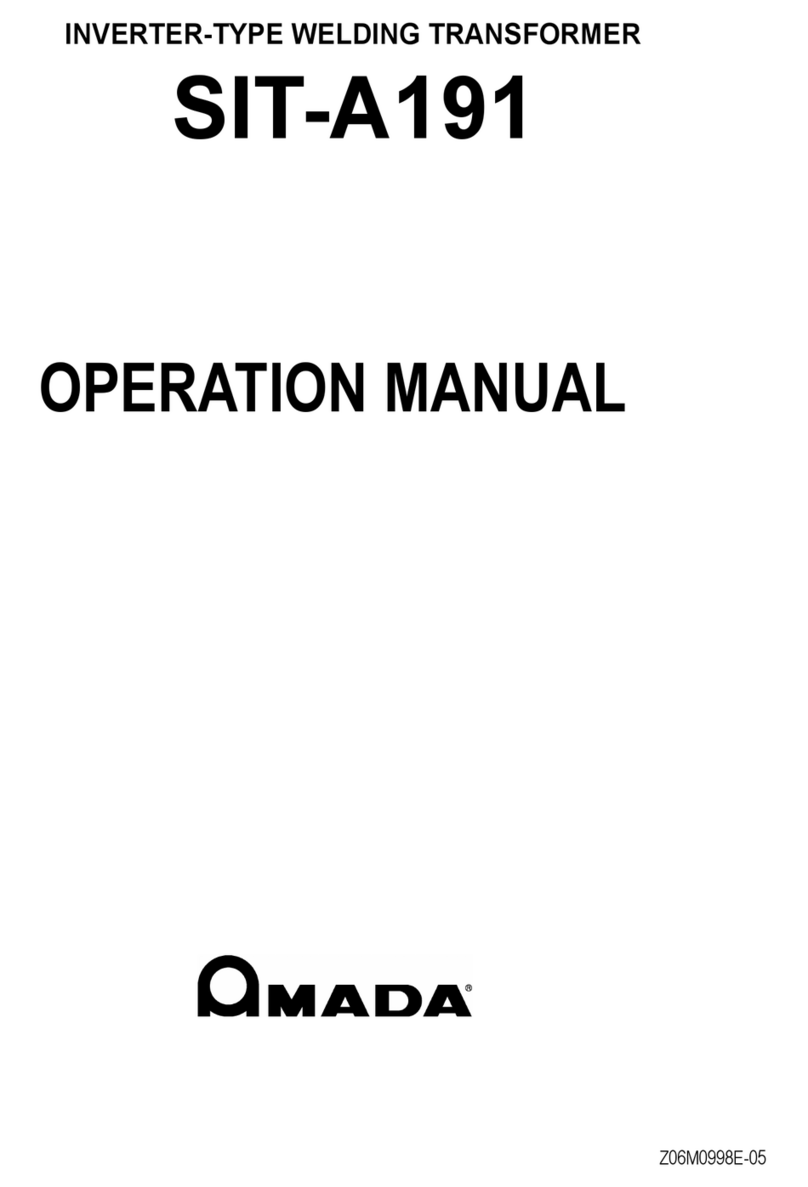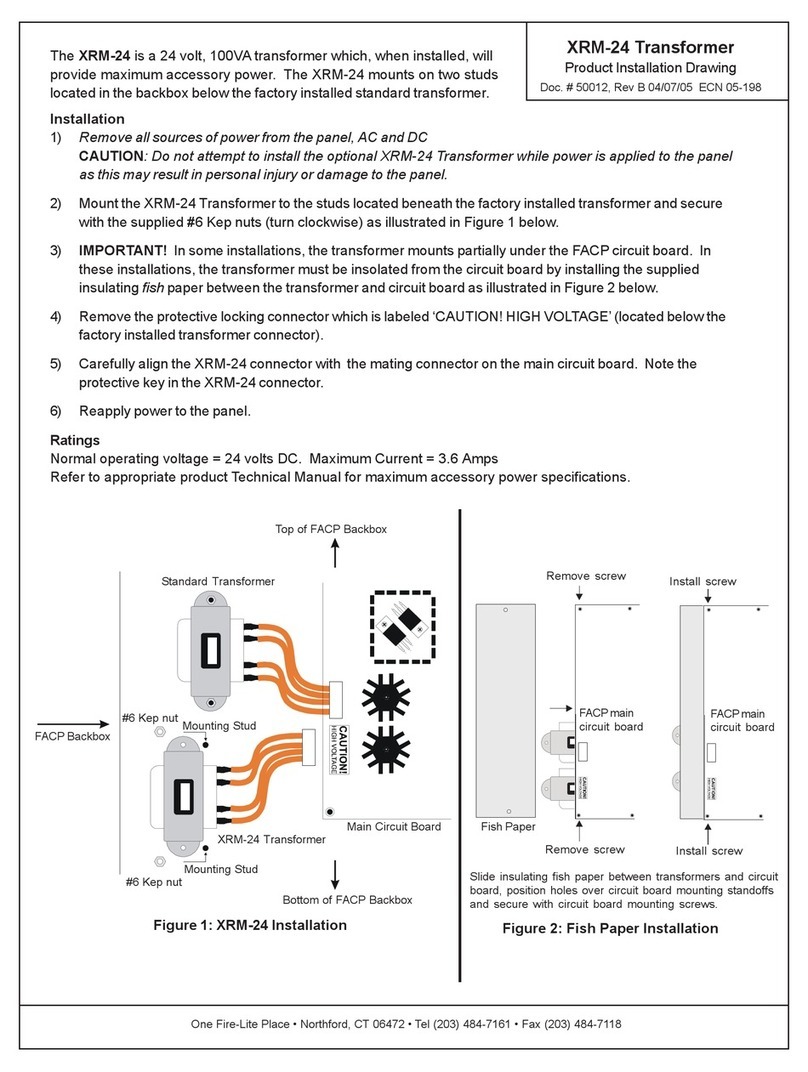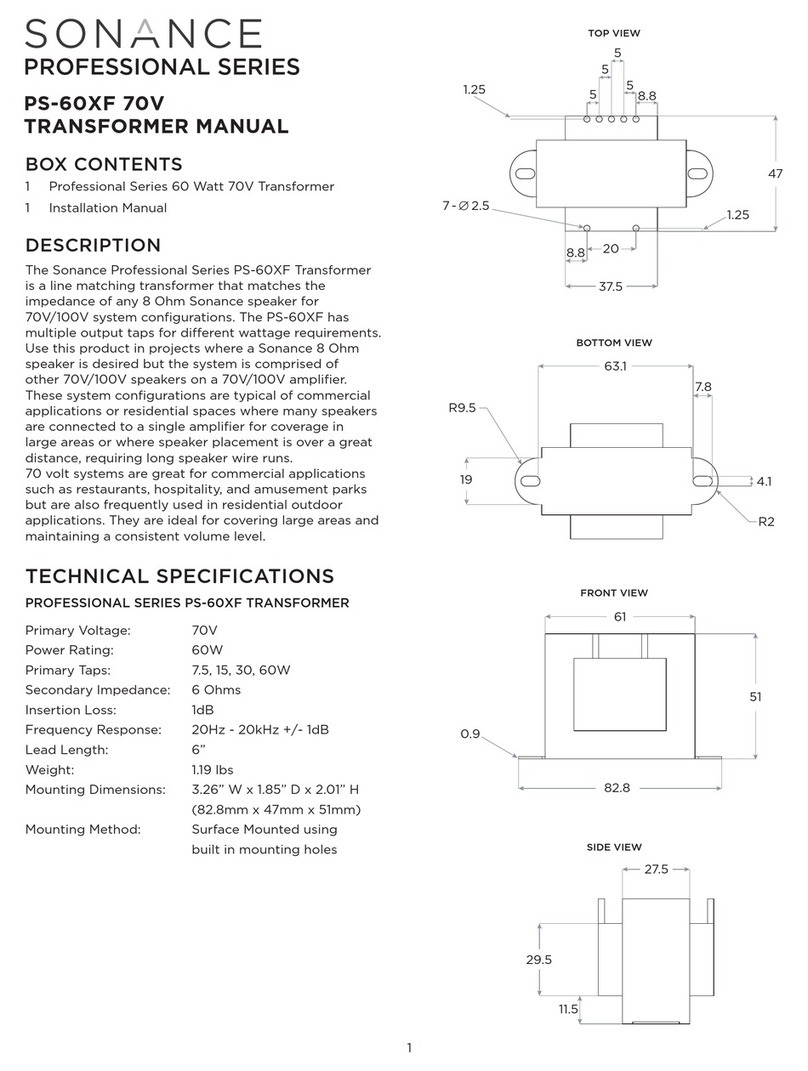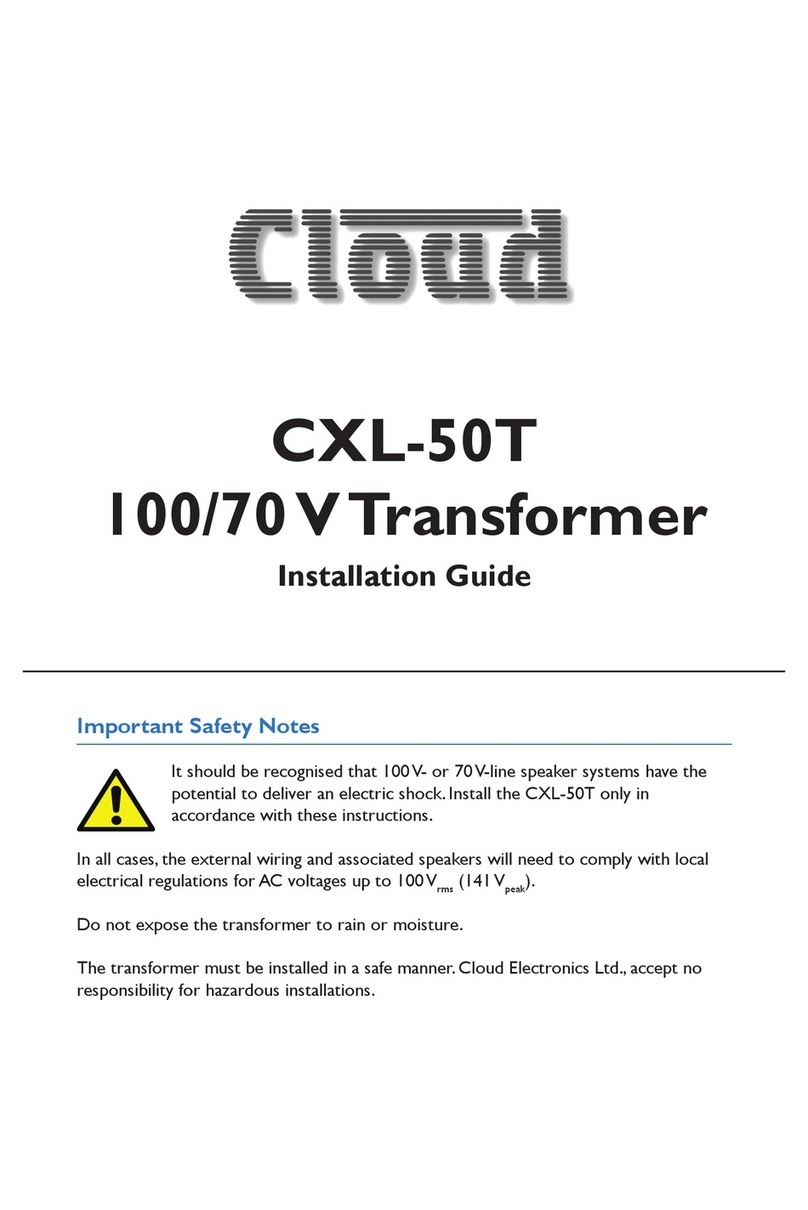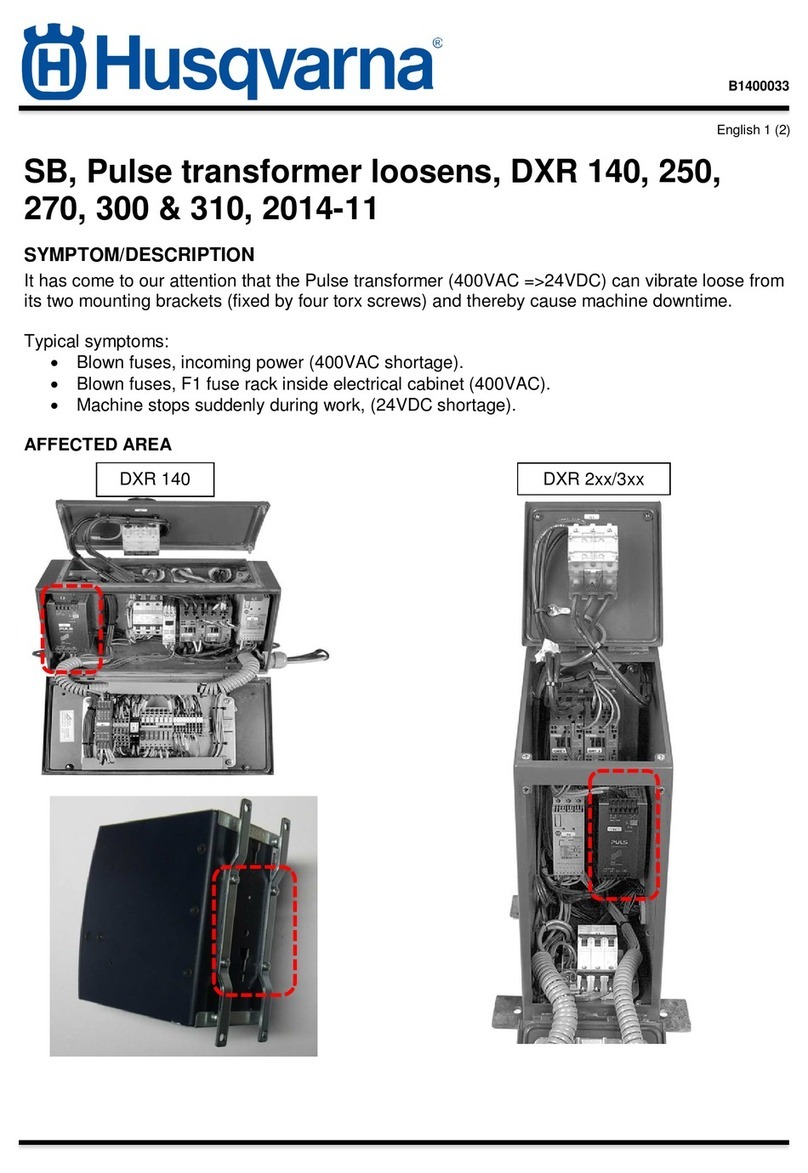RITZ ICO 72,5 User manual

Continued safety and installation instructions
The high voltage current transformer works on the principle of the inductive transformer. The secondary side is
galvanically separated from the primary side. It is used in switchgear, switching device combinations and power
distribution systems in connection with secondary devices (relays, meters, indication instruments). The instru‐
ment transformer is designed in oil-paper insulation technology. Head housing and base are made of aluminum
and galvanised steel, the insulator is made of silicone. Refer to the rating plate on the device for the operational
specications.
1 Oil level indicator
2 Ring bolts for transport purposes
3 Primary connection
4 Insulator
5 Oil drain screw
6 Earthing bolt holes
7 Terminal box with secondary terminals
8 Rating plate
UNPACKING
Check the transformer for completeness and damage.
Pay attention to sharp edges. You could get cut on them.
If the transformer shows any signs of external damage,
there is a risk of electric shock during commissioning.
STORAGE
Store the transformer at an ambient temperature between
-25°C and +40°C.
» The transformer must preferably be stored in a ver‐
tical position and screwed to the ground.
» If you store the transformer in a lying position, the
device must stand upright for at least 24 hours before
it can be put into operation.
Secure the intrument transformer against slipping, tilting
and falling down.
TRANSPORT
The transformer must be handled by trained personnel
using suitable transport equipment (crane). Please note
the transport instructions on the Òdimensional drawing.
Observe the weight specied on the Òrating plate. Caution:
the transformer is top-heavy!
» Means of transport permitting, the transformers may
be transported in a vertical position.
» Larger transformers are transported in a horizontal
position.
If any damage occurs during transport or storage, please
contact us directly.
Safety and installation instructions. Please read before use!
GB
ICO
High voltage current transformer for outdoor use Page
1/3
Version: 09/03/2020
GERMANY HAMBURG • WIRGES • KIRCHAICH • DRESDEN
AUSTRIA MARCHTRENK | HUNGARY KECSKEMÉT | CHINA SHANGHAI | USA HARTWELL
Continued on next page

Continued safety and installation instructions
NOTICE
Ensure a safe working environment during
installation, commissioning, shutdown and
during inspection work on the electrical system.
INSTALLATION
You may undertake the following installation work only if
you are a qualied electrician.
WARNING
Shut down the associated electrical system
before installation. Otherwise there is the risk of
suering an electric shock!
» Transport the transformer to the intended location.
Secure the base against movement. Bring the trans‐
former into the vertical position as described in the
ÒUser manual.
» Ensure that the mounting surface is even. Secure the
transformer using the base xture. Establish the
earthing connection at the transformer base. The
lifting xings should only be released after the trans‐
former has been fully secured!
» Avoid mechanical tension during operation. Ensure
that the instrument transformer is not subjected to
any dynamic loads such as vibrations, tensile forces or
knocks.
DANGER
You must not operate the secondary circuit of the
instrument transformer in open condition under
any circumstances. High voltages can occur at
the secondary terminals of the current trans‐
former with the secondary circuit open. There is
risk of death! The values of voltage induced in
the process also endanger the functional safety
of the instrument transformer.
COMMISSIONING
Ensure yourself that the instrument transformer is
installed properly and the secondary and primary cables
are connected correctly.
Have you checked the oil level via the oil level indicator?
Have you maintained the tightening torques specied? If
you have any questions, please ask an experienced col‐
league or contact us directly.
OPERATION
» During operation, never touch the primary or secon‐
dary terminals.
» Operate the transformer with the terminal box closed.
» Ensure that unauthorised persons and children cannot
access the instrument transformer.
» You must not operate the instrument transformer in
open condition (
Ò
Installation on page 2).
» Operate the instrument transformer only with an
intact composite insulator. Otherwise, you risk oil
leaking, greatly increased partial discharges and an
explosion of the instrument transformer.
SHUTDOWN
Shut down the associated electrical system. For your own
safety, earth the secondary circuit of the transformer.
Ensure that the system remains de-energised while
working on the instrument transformer.
DISMANTLING
Follow the work steps as described under
Ò
Shutdown
on page 2. Observe the safety instructions under
Ò
Instal‐
lation on page 2.
Then, loosen the secondary and primary terminals, the
base xtures and the earthing screws.
CLEANING
Follow the work steps as described under
Ò
Shutdown
on page 2. Observe the safety instructions under
Ò
Instal‐
lation on page 2.
» Regularly inspect the current transformer for external
soiling and damage, at least once a year and after spe‐
cial weather events (sandstorm, hail).
» Remove any soiling from the insulator at least once a
year as described in the ÒUser manual. After that, the
transformer must not be taken into use for at least
24 hours.
MAINTENANCE
The instrument transformer is maintenance-free with a
low pollution class and sucient ventilation (
Ò
Cleaning
on page 2).
Carry out a visual inspection at least once a year:
» Check the primary and secondary connection termi‐
nals and the screw ttings at the earthing connection.
» Check the oil level at the oil level indicator.
» Check the insulator for damage.
DO NOT RECTIFY FAULTS ON YOUR OWN!
The transformer cannot be repaired. If you suspect that the
transformer is faulty, please contact us immediately.
GB
ICO
High voltage current transformer for outdoor use Page
2/3
Version: 09/03/2020
GERMANY HAMBURG • WIRGES • KIRCHAICH • DRESDEN
AUSTRIA MARCHTRENK | HUNGARY KECSKEMÉT | CHINA SHANGHAI | USA HARTWELL
Continued on next page

Continued safety and installation instructions
DISPOSAL
Dispose of the transformer in accordance with the regula‐
tions of the country in which the transformer is used.
We accept no liability for incorrect installation.
Manufacturer: RITZ Instrument Transformers GmbH · Wandsbeker Zollstraße 92-98 · 22041 Hamburg · Germany
GB
ICO
High voltage current transformer for outdoor use Page
3/3
Version: 09/03/2020
GERMANY HAMBURG • WIRGES • KIRCHAICH • DRESDEN
AUSTRIA MARCHTRENK | HUNGARY KECSKEMÉT | CHINA SHANGHAI | USA HARTWELL

ICO 72,5...245
High voltage current transformer
User manual
HB ICO
Version: 01 / Stand 01.06.2021
GERMANY HAMBURG • WIRGES • KIRCHAICH • DRESDEN
AUSTRIA MARCHTRENK | HUNGARY KECSKEMÉT | CHINA SHANGHAI | USA HARTWELL
GB

©2021
All rights reserved. This document and any part thereof may only be copied or reproduced
with the explicit consent of our company.
This document does not refer to patents, trademarks or other proprietary rights which
can be linked with specic terms or entries. The absence of these references, however,
does not imply that the relevant terms or entries are free from these rights. Subject to
technical modications.
Manufacturer: RITZ Instrument Transformers GmbH · Wandsbeker Zollstraße 92-98 · 22041 Hamburg · Germany
ICO 72,5...245USER MANUAL
2/47

Table of contents
1 READ FIRST, THEN TAKE ACTION! 5
1.1 About this device 5
1.1.1 What is the device? 5
1.1.2 What is the purpose of the device? 6
1.2 About this manual 7
1.2.1 Who is this manual intended for? 7
1.2.2 How is this manual set out? 7
1.2.3 How do you use this manual? 8
1.3 For your safety 8
1.3.1 When is it dangerous to use the device? 8
1.3.2 Who is allowed to work with this device? 9
1.3.3 What are the obligations of the operator of this device? 9
1.3.4 Which legal aspects should you be aware of? 10
1.3.5 What should you do in the event of damage? 10
1.4 Special equipment 11
1.4.1 Primary reconnection 11
1.4.2 Secondary tapping 11
2 HOW TO USE THIS DEVICE AS INTENDED 13
2.1 Important general safety instructions 13
2.1.1 Working disconnected from voltage 13
2.1.2 Technically awless condition of the transformer 13
2.1.3 Deviating operating conditions 13
2.1.4 Structural changes 13
2.2 Unpacking 14
2.3 Installation 15
2.3.1 Installing the device 15
2.3.2 Earthing the device 19
2.3.3 Connecting the device 20
2.4 Commissioning 22
2.5 Operating 22
2.6 Shutdown 23
3 WHEN TO INTERRUPT THE RUNNING OPERATION 24
3.1 Cleaning and maintenance 24
3.1.1 Cleaning the device 24
3.1.2 Maintaining the device 26
ICO 72,5...245 USER MANUAL
Table of contents
3/47

3.2 Troubleshooting 30
3.3 Dismantling 32
3.4 Transport and storage 33
3.4.1 Transporting the device 33
3.4.2 Storing the device 37
3.5 Disposal 37
4 HOW WE AS THE MANUFACTURER CAN HELP 38
4.1 Repairs 38
4.2 Spare parts 38
4.3 Other queries 38
5 TECHNICAL DATA 39
5.1 Technical data 39
5.2 Environmental conditions 40
5.3 Rating plate 41
5.4 Circuit diagram 42
5.5 Technical illustration 43
6 SYMBOLS AND ABBREVIATIONS 44
6.1 Symbols and abbreviations 44
6.2 Safety labels 46
7 CONTACT / CUSTOMER SERVICE 47
ICO 72,5...245USER MANUAL
Table of contents
4/47

1 Read rst, then take action!
1.1 About this device
1.1.1 What is the device?
This device is a ICO type current transformer for outdoor use. The
current transformer is used to convert high alternating currents into
smaller, directly measurable currents according to the principle of the
inductive transformer. The secondary side is galvanically separated
from the primary side.
Other special properties of the ICO type current transformer are:
» The transformer is oil-paper insulated and hermetically sealed.
This protects the oil-paper insulation from external inuences and
oil maintenance is not required. A high-quality PCB-free insulating
oil in accordance with IEC and ASTM is used for insulation.
» The external insulation is provided by a polymer hollow core insu‐
lator. This consists of a glass-bre reinforced inner tube to which
silicone shields with aluminium anges are attached on the out‐
side. The screws on the insulator ange and the ttings at the top
and bottom are made of stainless steel and are tightened at the
factory according to the specications.
»Composite and porcelain insulators are available to cope with dif‐
ferent degrees of pollution and load classes. The standard model is
already designed for 31 mm/kV and load class 2.
» Corrosion-resistant components, a stainless steel expansion cell
and chambered O-ring seals ensure that it is maintenance-free
over the entire product life cycle.
»High-voltage windings with double enamel-coated magnet wire
ensure insulation between the windings.
» To change or vary the transformation ratio of a transformer, the
secondary windings can optionally be tapped (special equipment,
Ò
Chapter 1.4.2 Secondary tapping on page 11)
» The secondary connections are located in the marine-grade cast
aluminium terminal box at the front of the transformer base. A
removable and eld drillable aluminium plate is available on the
underside of the terminal box for the customer's cable glands. The
terminal box is prepared for the operation of an optional condensa‐
tion heating element.
» The electrical congurations from 72 kV nominal voltage up to the
voltage series listed on the device, maximum 245 kV, allow connec‐
tion to digital and conventional measuring and protection devices
such as switchgear, switching device combinations and power dis‐
tribution systems in connection with secondary devices (relays,
meters, indication instruments).
ICO 72,5...245 USER MANUAL
Read rst, then take action!
5/47

» An oil drain screw enables access to the oil chamber in the trans‐
former base. The oil level indicator on the head of the transformer
is optimised for the operator's viewing angle.
» Four transport eyes on the transformer base facilitate proper han‐
dling during installation.
For further information or details regarding the shield shape, ash‐
over distance and creepage path, please refer to the
Ò
Dimensional
drawing.
The device meets the relevant VDE-, IEC- and EN-standards. You will
nd the electrical data on the
Ò
Rating plate.
The type designation and specication of the device can be found
on the
Ò
Datasheet and the device's
Ò
Rating plate. The rating
plate is usually located at the front of the secondary terminal box.
Upon request, the ICO type transformer will be factory designed to
meet all national and international standards including IEEE /
ANSI, CSA, IEC as well as all customer requirements.
1.1.2 What is the purpose of the device?
The task of the current transformer is to transfer currents proportion‐
ally and phase-true such that they are detectable for measuring equip‐
ment at low potential.
The current transformer translates high currents into lower, directly
measurable currents, which are adapted to the downstream secondary
technology. The electrical congurations are suitable for digital and
conventional measuring and protection devices.
- Depending on the version, - the ICO type current transformer is suit‐
able for use at a maximum voltage for operating equipment (Um) of
72,5 kV, 123 kV, 145 kV, 170 kV or 245 kV.
The ICO type current transformers can be equipped with windings for
measuring and protection purposes. They are intended for use in
» switchgear, switching device combinations,
» power distribution systems in connection with secondary devices
(relays, meters, indication instruments).
ICO 72,5...245USER MANUAL
Read rst, then take action!
6/47

1.2 About this manual
1.2.1 Who is this manual intended for?
The target group includes everyone involved in the installation,
operation and maintenance of this device.
NOTICE
Please read this user manual carefully before commissioning the
device and observe all the regulations and information. This helps
prevent personal injury and damage to property.
1.2.2 How is this manual set out?
The theory section gets you ready to use the device safely and
correctly.
The practical section shows you how to connect the device and when to
disconnect it from the mains.
The fourth section deals with questions about repair and service.
Some of the information and illustrations in this manual may
dier from the features of your device. This includes details of
special equipment, abstractions and example illustrations.
The safety instructions are dierentiated according to the type and
severity of the hazard:
DANGER
Danger to life
WARNING
Warning of serious injury
Fig. 1: Read this user
manual rst than take
action!
Layout of the manual
Layout of the safety
instructions
ICO 72,5...245 USER MANUAL
Read rst, then take action!
7/47

CAUTION
Beware of health hazards and serious damage to property
NOTICE
Note on the possibility of considerable damage to property
1.2.3 How do you use this manual?
This user manual is part of the device you have received.
NOTICE
Keep this manual and all applicable documents available at all
times, to all users, at the place where the device is used.
In addition to this user manual, the applicable versions of the per‐
tinent national laws, regulations and provisions must be observed.
1.3 For your safety
1.3.1 When is it dangerous to use the device?
Any applications of the transformer not described in this user manual
could result in serious personal injury, or even death, and cause
serious damage to property. Any other or additional use as well as use
outside the permissible operating values (
Ò
Rating plate) contradicts
the intended use of the device.
Foreseeable misuse
ICO 72,5...245USER MANUAL
Read rst, then take action!
8/47

1.3.2 Who is allowed to work with this device?
Everyone involved in the installation, operation and maintenance of the
device must hold the appropriate qualications. In order to prevent
accidents, everyone who works with the transformer must meet the
following minimum requirements. They must:
» be a qualied electrician or a suitably instructed person under the
supervision of a qualied electrician,
» be able to implement the information in this user manual in a
professional manner,
» be capable of performing work on the device within the scope of
this user manual in accordance with safety requirements.
NOTICE
For safety reasons, everyone involved in the installation, operation
and maintenance of the device must be familiar with, have under‐
stood and follow this manual.
1.3.3 What are the obligations of the operator of this
device?
The operator is responsible for dening the responsibilities and
monitoring of the personnel. The operator must:
» ensure that everyone who works on the transformer has read and
understood this user manual,
» inform everyone who works on the transformer of the applicable
regulations regarding work, safety and accident prevention,
» provide everyone who works on the transformer with the
necessary protective equipment and advise them of the require‐
ment to wear it,
» train everyone who works on the transformer at regular intervals
and inform them of the risks,
» ensure that the transformer is only operated in a condition
compliant with safety requirements,
» be aware of the hazards arising from the auxiliary materials used.
» Furthermore, the operator may only employ personnel who are
specially qualied to handle the auxiliary materials.
Fig. 2: Working with
the device only per‐
mitted for electrotech‐
nical qualied per‐
sonnel
Fig. 3: Working on the
device only in personal
protective equipment
ICO 72,5...245 USER MANUAL
Read rst, then take action!
9/47

1.3.4 Which legal aspects should you be aware of?
No claims may be made for changes to devices already delivered
due to the specications, illustrations and descriptions in this user
manual.
We as the manufacturer are not liable:
» if you do not follow the instructions in this user manual,
» for direct damage or consequential damage due to incorrect instal‐
lation, operation or maintenance of this device,
» if you operate this device outside the specications given on the
rating plate,
» for personal injury or damage to property caused either wholly or
in part by untrained persons or by non-compliance with the regula‐
tions regarding work, safety and accident prevention.
1.3.5 What should you do in the event of damage?
WARNING
Damage to the device
Damage can impair the functionality and operational safety of the
transformer. This may cause personal injury.
» Remove the damaged transformer from service immediately.
» If necessary, contact the manufacturer
Ò
Chapter 7 Contact /
customer service on page 47.
In the event of transport damage or other defects, please take photo‐
graphs of the damaged components and the rating plate. Write a
damage report and send it to us, the manufacturer.
ICO 72,5...245USER MANUAL
Read rst, then take action!
10/47

1.4 Special equipment
1.4.1 Primary reconnection
Primary reconnection is possible with current transformers and com‐
bined current and voltage transformers with multiple primary wind‐
ings. Depending on the customer's requirement, it can be carried out in
a ratio of 1:1, 1:2 and 1:4.
NOTICE
Reconnection is provided by parallel or series connection of the
primary winding via reconnecting tabs in the
primary connection area. The power ratings, the overcurrent lim‐
iting factor and the secondary internal resistance values remain
unchanged with primary-side reconnection.
Circuit diagram for the primary reconnection
If the transformer is reconnectable on the primary side, the asso‐
ciated circuit diagram is located near to the primary conductor on
the head housing.
1.4.2 Secondary tapping
To change or vary the transformation ratio of a transformer, not only
the start and end of a winding are connected to the terminal, but also
one or more of its parts.
In transformers, usually the secondary windings, and less frequently
the primary windings, are tapped Ò Primary reconnection.
Fig. 4: Circuit diagram secondary tapping
ICO 72,5...245 USER MANUAL
Read rst, then take action!
11/47

Connection of the secondary technology at the terminals
S1-S2 low primary rated current (small ratio)
S1-S3 high primary rated current (large ratio)
ICO 72,5...245USER MANUAL
Read rst, then take action!
12/47

2 How to use this device as intended
2.1 Important general safety instructions
2.1.1 Working disconnected from voltage
During operation, the transformer is live at high voltage. When con‐
nected and not earthed on the high-voltage side, the transformer may
be live at high voltage. This can cause personal injury, even in the
vicinity of the transformer. The following applies before all work on the
transformer, such as installation, maintenance and troubleshooting:
» Disconnect the source of high voltage.
» Safeguard against reconnection.
» Ensure no voltage is present.
» Earth the device.
» Cover or block o adjacent live parts.
2.1.2 Technically awless condition of the transformer
External damage and improper handling or maintenance can impair
the operational safety of the transformer. There is a risk of accidents in
which people could be injured.
èOnly perform work on the undamaged transformer in accord‐
ance with these instructions!
2.1.3 Deviating operating conditions
Deviating operating conditions can impair the functionality and opera‐
tional safety of the transformer. This may cause personal injury.
èOperation only if the information in
Ò
Chapter 5.1 Technical
data on page 39 and
Ò
Chapter 5.2 Environmental conditions
on page 40 is taken into account.
2.1.4 Structural changes
Structural changes can impair the functionality and operational safety
of the transformer. This can result in personal injury, as well as
damage to adjacent operating equipment.
èDo not make any structural changes to the transformer!
ICO 72,5...245 USER MANUAL
How to use this device as intended
13/47

2.2 Unpacking
» Observe the notes on transport (
Ò
Chapter 3.4.1 Transporting the
device on page 33) and move the device to the place of use.
» Loosen the screw connection and the lashing of the device to the
transport frame.
» Unload the device from the transport vehicle using suitable aids
(textile hoisting slings / crane). Observe the instructions for lifting
the transformer under
Ò
Transporting and lifting in a horizontal
position, chap. 3.4.1.
» Check the following based on the dimensional drawing: Is the
device complete and undamaged? Be careful of sharp edges. You
could be injured!
NOTICE
If there is external damage to the transformer, personal and
operational safety are at risk
Ò
Chapter 1.3.5 What should you do
in the event of damage? on page 10.
ICO 72,5...245USER MANUAL
How to use this device as intended
14/47

2.3 Installation
2.3.1 Installing the device
Before you start the installation, think about your safety!
DANGER
High voltage in conductive components
There is danger to life through electric shock! Observe the
5 safety rules of electrical engineering.
» Disconnect the source of high voltage.
» Safeguard against reconnection.
» Ensure no voltage is present.
» Earth.
» Block o adjacent live parts.
1. Connect the transformer mechanically to the switchgear:
» Maintain the insulation distance between system components
and live surfaces!
» If present, remove the transport protection. Do not make any
structural changes to the transformer
Ò
Chapter 2.1.4 Struc‐
tural changes on page 13.
» Ensure that the installation surface is even.
» Level out any unevenness between the transformer and the
installation surface.
» The position of the transformer during installation is upright.
» Secure the transformer to the foundation. For xing dimen‐
sions please refer to the
Ò
Dimensional drawing. Depending
on the diameter of the drilled hole we recommend the fol‐
lowing bolt size:
Drilled hole Æ [mm]Bolt size
18 M16
24 M20
» The required tightening torques are shown in the table, refer
to
Ò
Table on page 19:
2. Ensure that the composite insulator is in perfect working order:
Fig. 5: Disconnect
mains!
ICO 72,5...245 USER MANUAL
How to use this device as intended
15/47

» Check the composite insulator for damage to and between the
insulator shields. If you notice any abnormalities, proceed as
described here:
Ò
Chapter 1.3.5 What should you do in the
event of damage? on page 10
» Clean the insulator if necessary. In this regard follow the
instructions as described under
Ò
Chapter 3.1.1 Cleaning the
device on page 24
3. Check the oil level:
Check the transformer for oil leaks.
Check the oil level using the oil level indicator on the head of the
transformer (see Fig.). For further information please refer to
Ò
Procedure step 7 on page 26
1
Fig. 6: Position of the oil level indicator on the ICO type current trans‐
former
1 Oil level indicator
èThe oil level indicator should be in the green area.
4. Prepare the transformer for connection on the primary side:
Always ensure a conductive contact at the primary connection
plates. If available, completely remove the protective coating (wax
emulsion) from the contact surfaces.
ICO 72,5...245USER MANUAL
How to use this device as intended
16/47

Cleaning of the contact surfaces
» Use a grease-dissolving cleaning agent such as white
spirit or acetone.
» Use a soft cloth or, if necessary, ne sandpaper to avoid
scratching the contact surfaces.
NOTICE
Do not use wire brushes when cleaning aluminium or
galvanised contact surfaces!
After cleaning, apply a thin layer of contact grease to the contact
surfaces. Only use auxiliary materials recommended and
approved by the manufacturer, e.g. Penatrox, special grease
Psterer MV.
CAUTION
Safe handling of auxiliary materials
Health hazards can arise from the auxiliary materials used,
depending on their chemical composition.
» It is essential to observe the safety datasheets of the
auxiliary materials, and the instructions and regulations
they contain.
5. Establish the primary connection at the transformer:
Screw the two primary terminals on the transformer to the
stranded conductor or rail of the switchgear.
Observe the required tightening torques, see
Ò
Table on page 19
ICO 72,5...245 USER MANUAL
How to use this device as intended
17/47
This manual suits for next models
1
Table of contents
Other RITZ Transformer manuals
Popular Transformer manuals by other brands
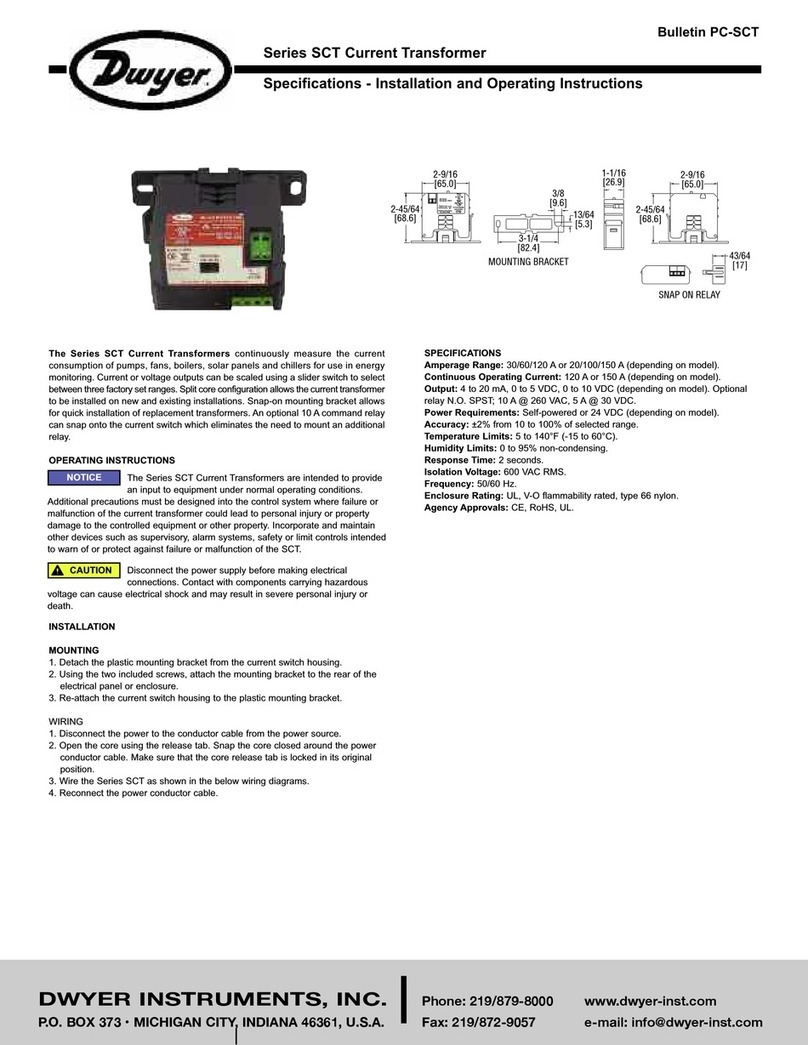
Dwyer Instruments
Dwyer Instruments SCT10-100 Installation and operating instructions
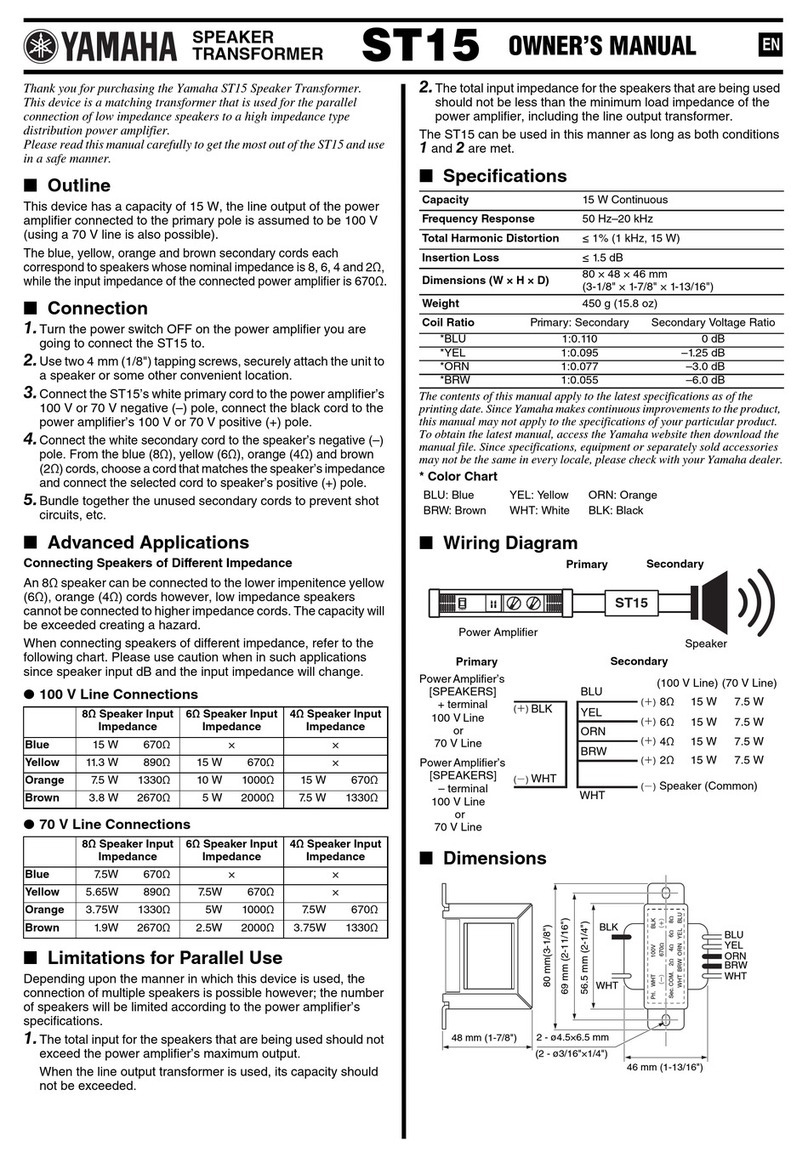
Yamaha
Yamaha ST15 owner's manual
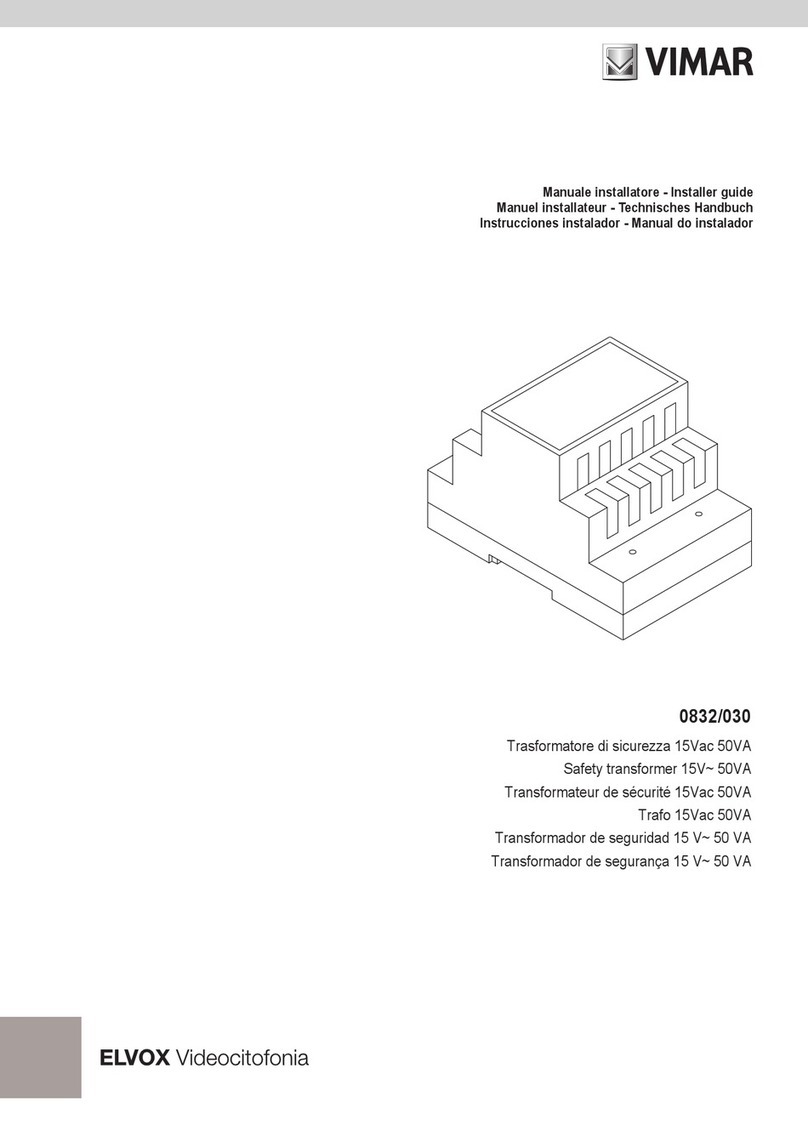
Vimar
Vimar ELVOX 0832/030 Installer's guide
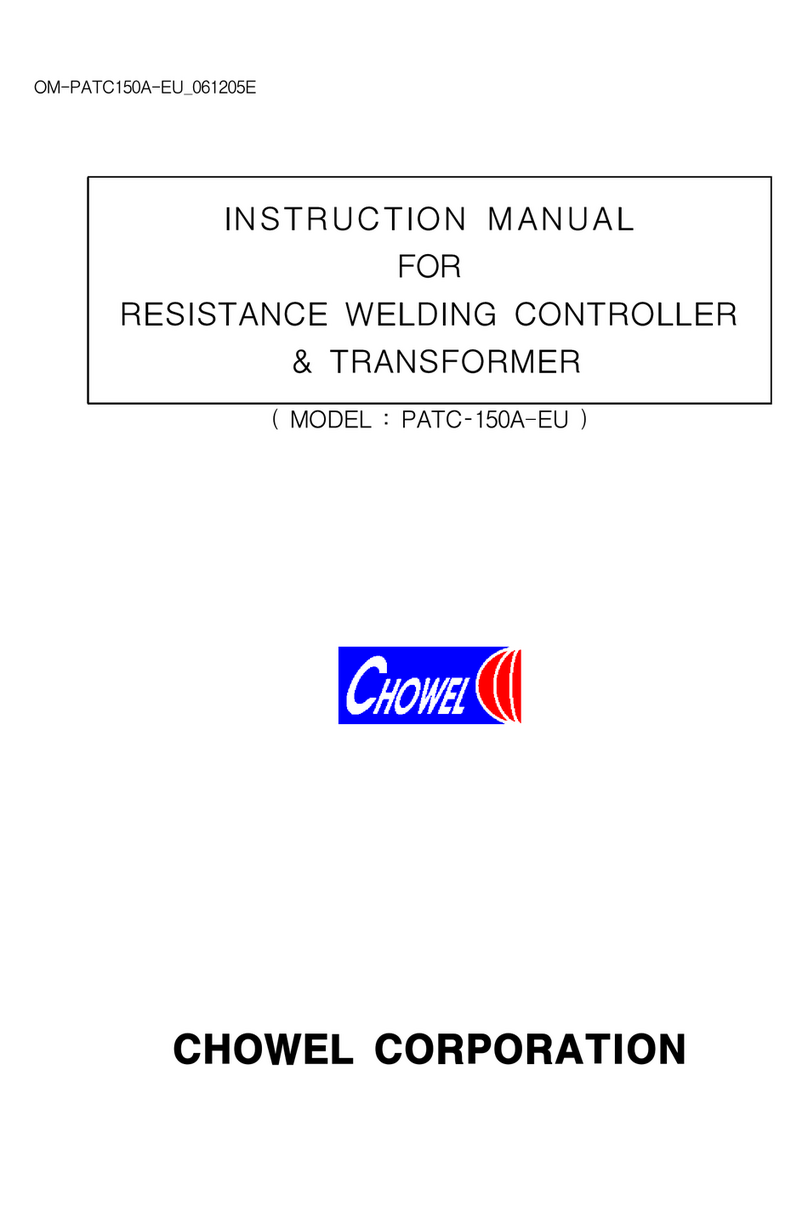
CHOWEL
CHOWEL PATC--150A-EU instruction manual

DX Engineering
DX Engineering Maxi-Core DXE-BAL450H10-BP Connection instructions

Eaton
Eaton Power-Sure 700 instruction manual
